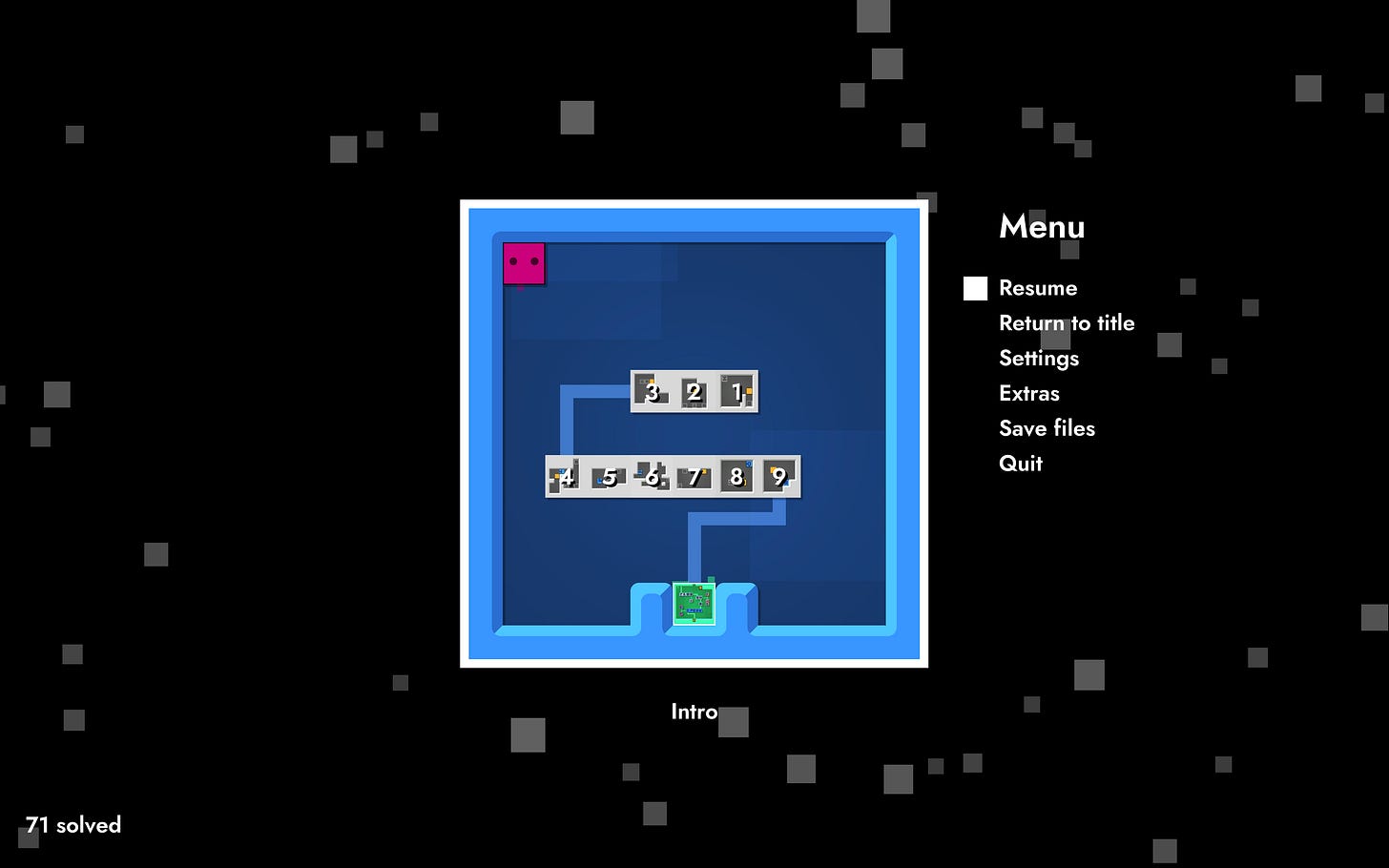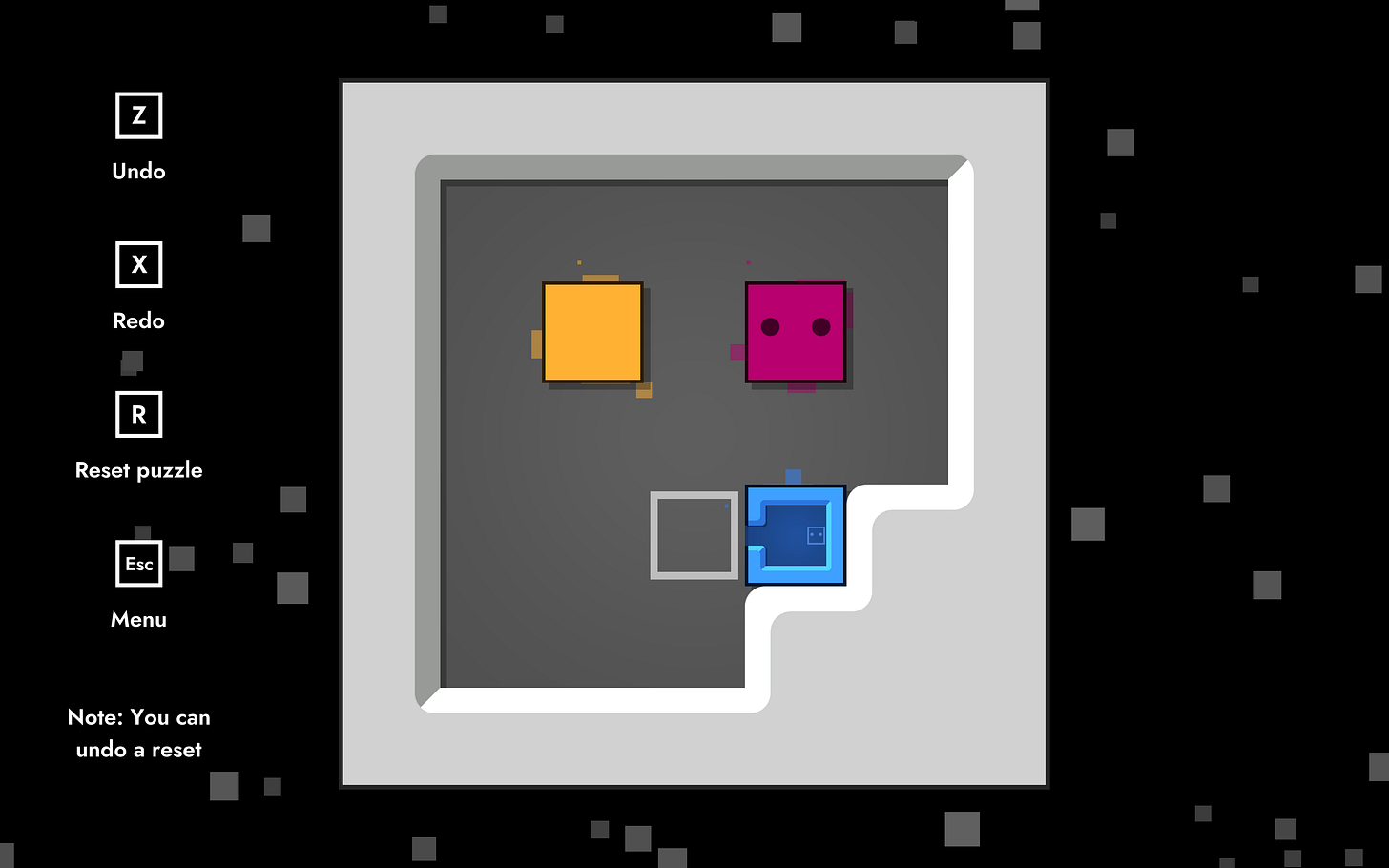Tutorial Design of Patrick's Parabox
Tutorials within tutorials within tutorials within tutorials
I've been playing Patrick's Parabox recently, a "mind-bending recursive puzzle game about boxes within boxes within boxes within boxes" made by Patrick Traynor (official site, Steam, itch.io, Nintendo eShop). I'm in World 8 of 20(ish)1 and am impressed by the level design. The levels have been laid out in an order that ensures you are effectively learning key concepts about the system as you play.
It made me think of other renowned 'World 1 Tutorial Levels'2 and I wanted to analyze the first world, level by level. I took notes3 on the Setup at the start and the Key to solving each level. This post contains those notes and a summary of my Design Takeaways.
SPOILER WARNING: some partial and some full solutions to the puzzles in the first world in the game. If you want to avoid the spoilers, skip ahead to the Design Takeaways.
World 1 Intro: Design Notes
Levels unlock in groups, which usually have some mechanic or theme tying them together. For example here, (1,2,3) and (4,5,6,7,8,9) are separate groups in World 1.
Group 1
Teaches basic controls and the goal of each puzzle.
Uses easier Sokoban puzzles.
Level 1
Setup:
- Movement buttons displayed on the side
- One block, one goal
Key:
- Move the Player Character
- Move the Yellow Block to the Goal
- Move the Player to the Player Goal
Level 2
Setup:
- Undo, Redo, Reset, and Menu buttons displayed on the side
- Two blocks, two goals
Key:
- Basic Sokoban puzzle, figure out how to move both blocks to the goal spaces without getting stuck
- You can move two (multiple) blocks in a line
- Use undo/reset liberally when you get stuck
Level 3
Setup:
- Undo, Redo, Reset, and Menu buttons displayed on the side
- Yellow block is against the wall, you can't obviously push it into place
Key:
- Push the block down until it does not touch the wall anymore
- Use the lower-right and then lower-left shape of the level to get around the block and push it into place up to the goal
Group 2
Introduces Blue blocks that you can enter into - now we're cooking with those promised paraboxes!
Level 4
Setup:
- One Blue, One Yellow block
Key:
- Push the Yellow Block into the Blue Block when it is up against the wall
- Impossible to mess up the solution, ensuring you learn the behaviour of these Blue Blocks
Level 5
Setup:
- One Blue Block
Key:
- Push the Blue Block onto the goal, then move through it to the player goal
Level 6
Setup:
- Blue Block (Upside-down 'T' shaped interior)
Key:
- Move the Blue Block along towards the goal, Enter and move through it to push from previously inaccessible positions
- Repeat this 4 times to reinforce the idea
Level 7
Setup:
- Blue Block (L-shaped interior) right next to Yellow Block
Key:
- Push the Yellow Block one space away from inside the Blue Block
Level 8
Setup:
- Goal is inside the Blue Block
Key:
- Push Yellow Block inside Blue Block and complete
Level 9
Setup:
- Yellow Block Goal is just outside Blue Block
- Player Goal is inside the Blue Block
Key:
- Push Yellow Block into Blue Block and then Sokoban it out of there
Design Takeaways
Teach a maximum of one new concept in a level
Reinforce concepts through repetition: within a level and across multiple levels
Combining concepts is a great way to generate new level design ideas
Allow players the freedom to work on other puzzles so their subconscious mind has space to work on them before they consciously return to a puzzle that stumps them.4
It's always a challenge to effectively teach your players your game systems. As the designer, you carry the expert's curse with you since you've probably spent more time than anyone in the system. It takes conscious effort to break down the complex machinery into digestible chunks of gameplay for your player to learn from.
Still, it's a challenge well worth reckoning with since we want to share the intricacies and depth of our game with players. Though I must say that I have renewed respect for all my teachers all over again.
There are 3 Appendix Worlds. I tip my hat to the amount of content in this game.
While Super Mario World 1-1 has been famously dissected to death, Metroid Fusion is one of my personal faves.
With good ol' pen and paper. When I tell my friends that I play games seriously for research, I mean it!
This is apparent in World 2 (Enter) onwards in Patrick's Parabox. There are always plenty of options to try other levels if you're stuck on any particular one.











